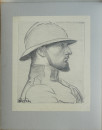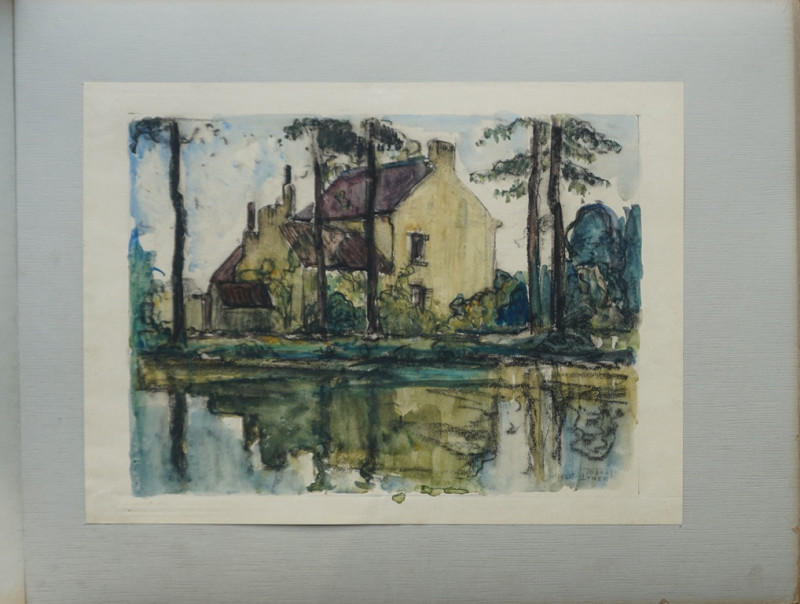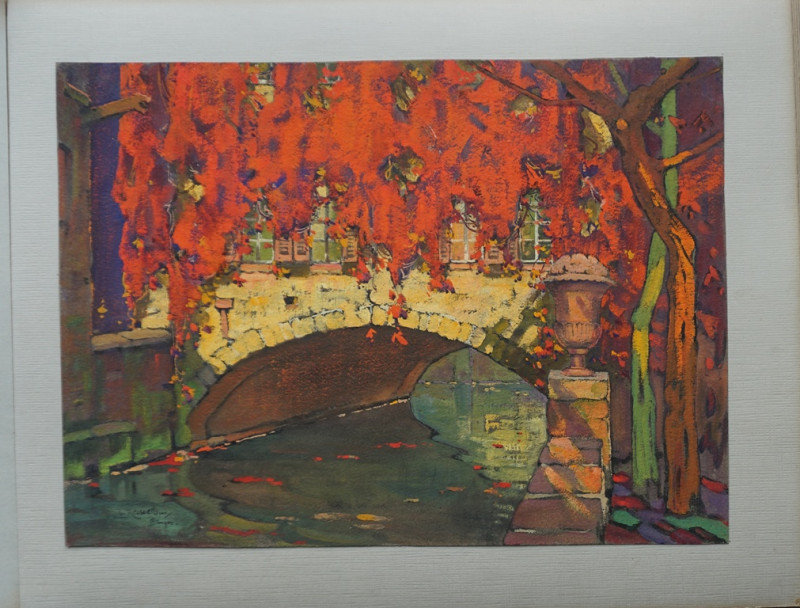Unique commemorative album to be presented to the London based “Arts Club” on Dover Street, Mayfair, by 30 Belgian World War I refugee artists

















Book Description
Unique commemorative album to be presented to the London based “Arts Club” on Dover Street, Mayfair, by 30 Belgian World War I refugee artists, containing 32 original artworks from the period (1915)-1925, in a commissioned deluxe binding, entitled “To the “Arts Club” A token of gratitude from Belgian artists for the kind hospitality bestowed upon them during the great war.”
32 different original artworks in various techniques (drawings, etchings, watercolours, gouaches, lithographs), by i.a. Emile Claus, Marcel Jefferys, Alfred Jonniaux, Leon de Smet, Pierre Paulus, Louis Reckelbus, Valerius de Saedeleer, Belgium, ca.(1915)-1925), calligraphed presentation leaf by Hélène Stordeur listing the contributing artists and illustrated with two coats of arms (on the left an undetermined British coat of arms divided in four; on the right the Lion of Flanders) within a finely decorated ornamental border in two shades of yellow, all housed in a massive deluxe heavy leather album of black hardgrained morocco with a gilt fillet line along cover-edges, front panel with two burgundy red onlaid borders flanked by gilt fillet lines and with two connecting burgundy red blindtooled floral ornaments between these borders, the inner panel with giltlettered presentation text, spine with raised bands with gilt and blindtooled compartments, boardedges gilt, gilt inside dentelles, handmade marbled blue doublures and endpapers, handbound by J. Labruyère rel., 50,7 (h.) x 68,6 (w.) x 5,8 (d.) cm. (weight: 12 kgs.).
Dealer Notes
= A one-off commemorative luxury “thank you”- art album from Belgian artists for “The Arts Club” (London) containing 32 genuine artworks by 30 Belgian exile artists, all tipped-in on grey board mounts. These artists were part of a group of hundreds of Belgian artists fleeing the German occupation from 1914 who found exile in the United Kingdom and were welcomed by The Arts Club and other clubs, societies and benefactors.
“The Arts Club” was (and still is on this day) located on Dover Street in Mayfair, London and was founded in 1863 “to provide a sanctuary for those with a professional or amateur relationship with the Arts, Literature or Sciences”.
Contains the following artworks in order of the album (a PDF with full description and images is available on request):
1. (the late) A. Baertsoen (1866-1922) – etching
2. the late) Maurice Blieck (1876-1922) – etching
3. (the late) Georges Buysse (1864-1916) – lithograph
4. Juliette Cambier (1879-1963) – gouache on paper
5. Louis-Gustave Cambier (1874-1949) – aquatint etching
6. Julien Célos (1884-1953) – watercolour
7. Albert Claes-Thobois (1883-1945) – gouache on canvas
8. (the late) Emile Claus (1849-1924) – lithograph
9. André Cluysenaar (1872-1939) – pencil drawing
10. Hippolyte Daeye (1873-1952) – lacking
11. A. Delstanche (1871-1941) – ink drawing
12. Valerius de Saedeleer (1867-1941) – coloured crayon and gouache on paper
13. Léon De Smet (1881-1966) – lithograph
14. Émile Fabry (1865-1966) – charcoal drawing
15. (the late) Marcel Jefferys (1872-1924) – aquatint etching
16. Alfred Jonniaux (1882-1974) – watercolouron paper
17. André Lynen (1888-1984) – watercolour and charcoal on paper
18. Alexandre. Marcette (1953-1929) – watercolour on board
19. (the late) Charles Mertens (1865-1919) – etching
20. John Michaux (1876-1956) – watercolour on paper
21. Fernand Verhaegen (1883-1975) – handcoloured etching and aquatint
22. Isidoor Opsomer (1878-1967) – aquatint etching
23. Isidoor Opsomer (1878-1967) – aquatint etching
24. Pierre Paulus (1881-1959) – coloured lithograph on Japanese
25. Pierre Paulus (1881-1959) – aquatint etching on Japanese
26. Louis Reckelbus (1864-1958) – gouache on paper
27. Victor Rousseau (1865-1954) – charcoal drawing
28. Jean-Guillaume (Jan-Willem) Rosier (1858-1931) – charcoal drawing
29. Fernand Scouflaire (1885-1977) – charcoal drawing w. accents in blue and white crayon
30. Michel Sterckmans (1883? - ?) – gouache on paper
31. Edgar Tytgat (1879-1957) – lacking
32. Jenny Montigny (1875-1937) – tinted etching on Japanese
33. Maurice Wagemans (1877-1927) – charcoal drawing and wash
34. Auguste Puttemans (1878-1962) – lacking
35. Charles Houben (1871-1931) – gouache on paper
Reference: Caterina Verdickt - IN: Kunst in ballingschap, Vlaanderen, Wales en de Eerste Wereldoorlog [Art in Exile, Flanders, Wales and the Great War], (2002), pag.53ff. (paraphrased):
The German attack on Belgian territory on August 4, 1914 comes as a total surprise. After the violation of Belgium's neutrality, Great Britain immediately acts as a defender of Belgium against the German aggressor. Some sixty Belgian artists will spend the war years in Great Britain, such as Hippolyte Daeye, Edgar Tytgat, Jules de Bruycker, Jan de Clerck, Emile Claus, Jean Delville and Victor Rousseau.
The British art dealers, museums and galleries are trying to help Belgians in need, for instance with charity exhibitions, such as for example the Exhibition of Works given by Belgian Artists, which is organised in the Goupil Gallery for the benefit of the Fund for Immediate Relief in Belgium.
In addition to galleries, the president of the Royal Academy of Arts, Edward J. Poynter, wants to involve official bodies in organizing charity exhibitions and finds much support. For example, a list of 53 artists living in Great Britain is circulating and Poynter suggests that these artists should also be included in the War Relief Exhibition, so that the British public can become acquainted with the Belgian contemporary artists.
The London based “The Arts Club” – which is still located on Dover Street today – is also involved and grants all artists on the list free access to the library of the Royal Academy in London.
The group of artists received extensive attention in the British press and A Book of Belgium's Gratitude was published in 1916, describing, among other things, how warmly British artists received their exiled colleagues. The Chelsea Club, The Arts Club and Ridley Art Club show their support by providing the refugees with benefits, employment and connecting them with English colleagues. The British painters and sculptors put their studios in London and the surrounding area at the disposal of the Belgian refugees.
Paul Buschmann writes in 1914 in a series of articles to promote Belgian art that Belgian artists are characterized by great adaptability. Once they get over the initial shock, they will discover Britain's own beauty. He sees the forced stay more as an opportunity to broaden horizons than as a painful exile. He is convinced that the introduction to British nature and culture will benefit their art. He is also positive about the great interest of the British public in Belgian art.
Condition:
Three of the artworks by contributing artists (as listed on the presentation-leaf) have unfortunately been taken from the album (Daeye, Puttemans and Tytgat); another artist that is listed but from whom no artwork is present, is De Bruycker, but there seems not to be lacking an artwork from him (it was possibly never donated). Some artworks loose or loosening, some with glue showing through; the calligraphed presentation leaf loose and frayed. Binding partly chafed/ worn.
“The Arts Club” was (and still is on this day) located on Dover Street in Mayfair, London and was founded in 1863 “to provide a sanctuary for those with a professional or amateur relationship with the Arts, Literature or Sciences”.
Contains the following artworks in order of the album (a PDF with full description and images is available on request):
1. (the late) A. Baertsoen (1866-1922) – etching
2. the late) Maurice Blieck (1876-1922) – etching
3. (the late) Georges Buysse (1864-1916) – lithograph
4. Juliette Cambier (1879-1963) – gouache on paper
5. Louis-Gustave Cambier (1874-1949) – aquatint etching
6. Julien Célos (1884-1953) – watercolour
7. Albert Claes-Thobois (1883-1945) – gouache on canvas
8. (the late) Emile Claus (1849-1924) – lithograph
9. André Cluysenaar (1872-1939) – pencil drawing
10. Hippolyte Daeye (1873-1952) – lacking
11. A. Delstanche (1871-1941) – ink drawing
12. Valerius de Saedeleer (1867-1941) – coloured crayon and gouache on paper
13. Léon De Smet (1881-1966) – lithograph
14. Émile Fabry (1865-1966) – charcoal drawing
15. (the late) Marcel Jefferys (1872-1924) – aquatint etching
16. Alfred Jonniaux (1882-1974) – watercolouron paper
17. André Lynen (1888-1984) – watercolour and charcoal on paper
18. Alexandre. Marcette (1953-1929) – watercolour on board
19. (the late) Charles Mertens (1865-1919) – etching
20. John Michaux (1876-1956) – watercolour on paper
21. Fernand Verhaegen (1883-1975) – handcoloured etching and aquatint
22. Isidoor Opsomer (1878-1967) – aquatint etching
23. Isidoor Opsomer (1878-1967) – aquatint etching
24. Pierre Paulus (1881-1959) – coloured lithograph on Japanese
25. Pierre Paulus (1881-1959) – aquatint etching on Japanese
26. Louis Reckelbus (1864-1958) – gouache on paper
27. Victor Rousseau (1865-1954) – charcoal drawing
28. Jean-Guillaume (Jan-Willem) Rosier (1858-1931) – charcoal drawing
29. Fernand Scouflaire (1885-1977) – charcoal drawing w. accents in blue and white crayon
30. Michel Sterckmans (1883? - ?) – gouache on paper
31. Edgar Tytgat (1879-1957) – lacking
32. Jenny Montigny (1875-1937) – tinted etching on Japanese
33. Maurice Wagemans (1877-1927) – charcoal drawing and wash
34. Auguste Puttemans (1878-1962) – lacking
35. Charles Houben (1871-1931) – gouache on paper
Reference: Caterina Verdickt - IN: Kunst in ballingschap, Vlaanderen, Wales en de Eerste Wereldoorlog [Art in Exile, Flanders, Wales and the Great War], (2002), pag.53ff. (paraphrased):
The German attack on Belgian territory on August 4, 1914 comes as a total surprise. After the violation of Belgium's neutrality, Great Britain immediately acts as a defender of Belgium against the German aggressor. Some sixty Belgian artists will spend the war years in Great Britain, such as Hippolyte Daeye, Edgar Tytgat, Jules de Bruycker, Jan de Clerck, Emile Claus, Jean Delville and Victor Rousseau.
The British art dealers, museums and galleries are trying to help Belgians in need, for instance with charity exhibitions, such as for example the Exhibition of Works given by Belgian Artists, which is organised in the Goupil Gallery for the benefit of the Fund for Immediate Relief in Belgium.
In addition to galleries, the president of the Royal Academy of Arts, Edward J. Poynter, wants to involve official bodies in organizing charity exhibitions and finds much support. For example, a list of 53 artists living in Great Britain is circulating and Poynter suggests that these artists should also be included in the War Relief Exhibition, so that the British public can become acquainted with the Belgian contemporary artists.
The London based “The Arts Club” – which is still located on Dover Street today – is also involved and grants all artists on the list free access to the library of the Royal Academy in London.
The group of artists received extensive attention in the British press and A Book of Belgium's Gratitude was published in 1916, describing, among other things, how warmly British artists received their exiled colleagues. The Chelsea Club, The Arts Club and Ridley Art Club show their support by providing the refugees with benefits, employment and connecting them with English colleagues. The British painters and sculptors put their studios in London and the surrounding area at the disposal of the Belgian refugees.
Paul Buschmann writes in 1914 in a series of articles to promote Belgian art that Belgian artists are characterized by great adaptability. Once they get over the initial shock, they will discover Britain's own beauty. He sees the forced stay more as an opportunity to broaden horizons than as a painful exile. He is convinced that the introduction to British nature and culture will benefit their art. He is also positive about the great interest of the British public in Belgian art.
Condition:
Three of the artworks by contributing artists (as listed on the presentation-leaf) have unfortunately been taken from the album (Daeye, Puttemans and Tytgat); another artist that is listed but from whom no artwork is present, is De Bruycker, but there seems not to be lacking an artwork from him (it was possibly never donated). Some artworks loose or loosening, some with glue showing through; the calligraphed presentation leaf loose and frayed. Binding partly chafed/ worn.
Author
[World War I].
Date
ca.1925
Binding
massive deluxe heavy leather album of black and onlaid burgundy red morocco, giltlettered presentation text, handbound by J. Labruyère rel., 50,7 (h.) x 68,6 cm. (weight: 12 kgs.).
Publisher
n/a
Condition
Lacking 3 artworks; some artworks loose or loosening, some with glue showing through; the calligraphed presentation leaf loose and frayed. Binding partly chafed/ worn.
Price: £19500.00
Offered by Fahrenheit 451 Antiquarian Booksellers
Friends of the PBFA
For £10 get free entry to our fairs, updates from the PBFA and more.
Please email info@pbfa.org for more information
























